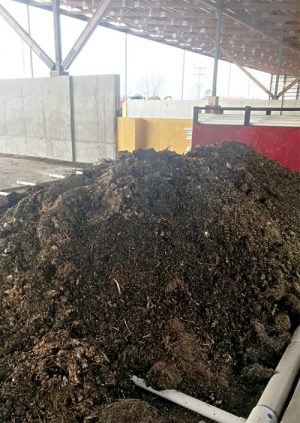BioCycle March/April 2018
Sacramento, California: Alternative Manure Management Project Grants
The California Department of Food and Agriculture (CDFA) awarded $9.64 million in grant funding to 17 alternative manure management projects across the state. These projects, part of the Alternative Manure Management Program, or AMMP, will reduce greenhouse gas (GHG) emissions on California dairy farms and livestock operations by using manure management practices that are alternatives to dairy digesters (i.e. non-digester projects). The primary management methods to be used by grantees include solar drying of manure solids, composting, or use of separated manure solids in compost bedded pack barns, where bedding material is aerated twice daily using a cultivator or chisel plow type of equipment to dry the surface and incorporate manure into the pack.
One awardee, Lafranchi Ranch, will convert an existing flush system on a third generation dairy in Marin County to dry scrape. The dairy hosts an on-farm composting facility that meets the needs of the local community for organics recycling and is affiliated with the Marin Carbon Project and the Marin Resource Conservation District. The University of California, Berkeley is conducting research at the site to measure GHG fluxes from the composting process under various conditions and feedstocks.
Lima, Ohio: Public-Private Composting At Correctional Institution

Allen-Oakwood Correctional Institution (AOCI) in Lima officially opened its Class II aerated static composting facility in a retrofitted cattle barn in January.
Barnes Nursery provides food scraps collection and trucking of inbound waste streams and outbound finished products, as well as marketing and distribution of the finished product. Ohio EPA awarded grants for equipment, including a food waste collection truck (Barnes matched the grant amount for the truck). Salaries for all AOCI offender-staff and half of the supervisor salary are paid by Barnes. A feature article on the AOCI composting facility will appear in the May issue of BioCycle.
Frederick, Maryland: County Expands Food Waste Composting Options
Frederick County is developing legislation that would allow limited food waste composting on agricultural and commercial properties. For several years, the county has explored options to remove food waste from its trash, which goes to landfills in Pennsylvania. The legislation would allow agricultural properties to compost food waste generated off-site on up to 5 acres; commercial properties could use up to 10 acres for compost businesses after site plan review and approval. “The purpose of this legislation was to allow a limited composting facility on farms without farmers having to go through the long, expensive process” of getting zoned, Michael Wilkins, acting director of the county’s Department of Development Review told the Frederick News-Post.
The draft legislation, as currently written, requires that both agricultural and commercial composting properties be sited a minimum of 25 feet from flood plain districts and 50 feet from the banks of streams, and a minimum of 150 feet from the property line, adds the Frederick News-Post article. The county already has a Solid Waste District “floating” zone that can be applied to agricultural and some industrial properties when there is a corresponding land use designation in the county’s comprehensive plan. The state of Maryland currently allows composting on up to 5,000 square feet of land without needing to apply for a Solid Waste Compost Permit.
Springfield, Ohio: Composting Facility Planned In West-Central Ohio
David Andre, an entrepreneur who runs GoZERO, a food scraps collection business serving Columbus, Cincinnati and Dayton, Ohio, received a grant of $250,000 from the Ohio EPA for his other company, Econopia, to build a rotary-drum food waste composting facility on an industrial 5-acre site. The grant was received in collaboration with the Clark County Solid Waste District and was supported by the City of Springfield.
Andre, a relative of Nate Andre, founder of Andre Farm composting facility in northwest Ohio, is planning to construct a roofed facility with a contamination removal area, a mechanical mixer, two 40-foot long DTE Environmental rotary drums, outdoor curing, covered screening and product storage. The industrially zoned site has been a challenge to develop because it is located between two railroad tracks. Composting is an allowed use in that zone.
Napa, California: Food Waste Facility Upgrade
The City of Napa approved a $10.4 million upgrade of its food waste composting facility as a result of a design-build solicitation issued in July 2017. The project will enable the City to convert from open windrow composting to positively aerated static piles covered with a 12-inch compost cap during the active and curing phases. Capacity of the facility will be increased from 40,000 to 66,640 tons/year.
The upgrade also features a redesigned drainpipe system directing storm water into a single collection pond, where 1,000 gallons of runoff can be treated per minute. The City will also install a protective canopy over the composting area, at a cost of $2.1 million, to reduce the potential for storm water runoff pollution. The upgrade is scheduled for completion in February 2019. The city’s composting facility is operated by Napa Recycling & Waste Services.










